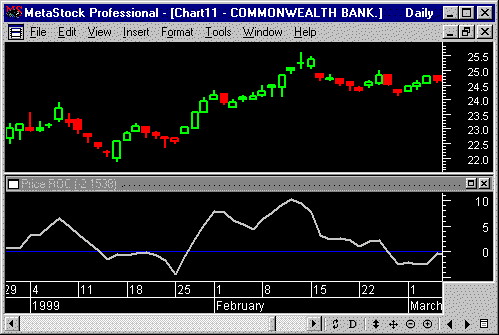|
Price Rate-Of-Change

Description
The Price
Rate-Of-Change (R.O.C.) indicator
(percent method) is calculated by
dividing the price change over the last
x-periods by the closing price of the
security x-periods ago. The result is
the percentage that the security's price
has changed in the last x-periods.
If the
security's price is higher today than
x-periods ago, the R.O.C. will be a
positive number. If the security's price
is lower today than x-periods ago, the
R.O.C. will be a negative number.
Interpretation
A long
recognized phenomenon of security prices
is the fact that prices tend to surge
ahead and retract in a cyclical
wave-like motion. The Price
Rate-Of-Change indicator illustrates
this wave-like motion of a security's
price in an oscillator format. As the
security's price increases, its R.O.C.
will rise; conversely, as its price
falls, its R.O.C. will fall. The faster
prices rise or fall, the faster the
R.O.C. will rise or fall.
MetaStock
Pro allows you to select the time period
used in the R.O.C. calculation. The time
period may range from a very short 1-day
R.O.C. (which causes an erratic chart)
to a long-term 200-day (or longer) R.O.C.
The most popular time periods are the
12-day and 25-day R.O.C. for short to
intermediate-term trading and a 1-year
(255-day) R.O.C. for long-term analysis.
The 12-day
R.O.C. is best used as a short to
intermediate-term overbought/oversold
indicator. The higher the R.O.C., the
more overbought the security; the lower
the R.O.C., the more likely a rally.
However, as with all
overbought/oversold indicators, it is
best to wait for the market to begin to
correct (i.e., turn up or down) before
placing your trade. A market that
appears overbought may remain overbought
for some time. In fact, extremely
overbought/oversold readings usually
imply a continuation of the current
trend.
The 12-day
R.O.C. tends to be very cyclical,
oscillating back and forth in a fairly
regular pattern. Often, price changes
can be anticipated by studying the
previous cycles of the R.O.C. and
relating the previous cycles to the
current market.
The optimum
overbought / oversold levels (e.g.,
+/-5) will vary depending on the
security being analyzed and overall
market conditions. In strong bull
markets, it is usually beneficial to use
higher levels, perhaps +10 and -5. |